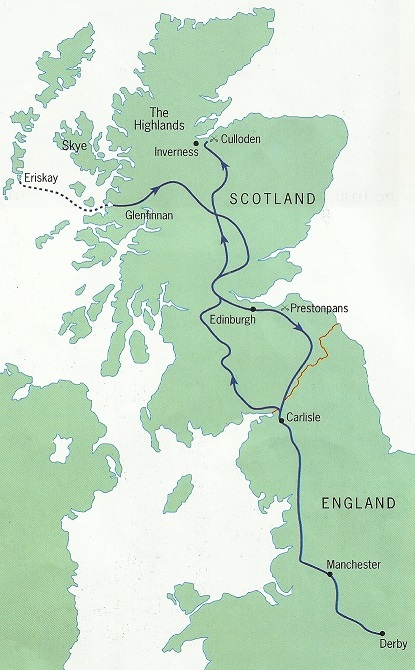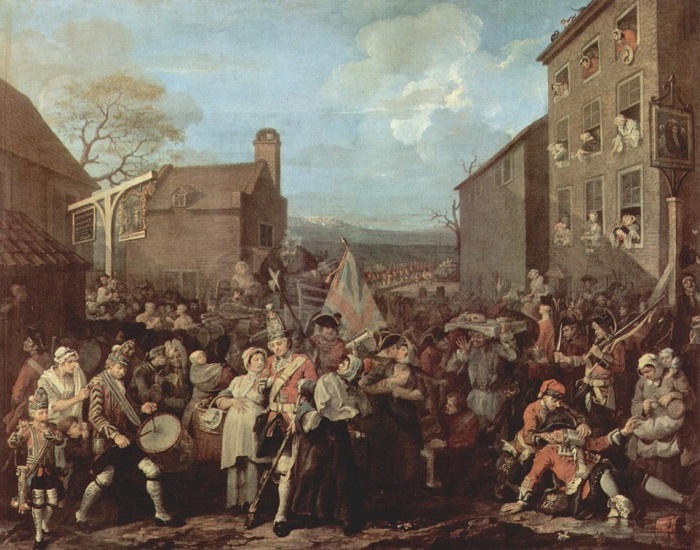
Scotland and the Act of Union

Introduction
Until the eighteenth century, Scotland was an independent country with its own Parliament. By the Act of Union (1707), however, England and Scotland became a United Kingdom. Many Scots hated the Union.
After the Glorious Revolution of 1688, James II had gone to live in France. Those Scots who hated the Union hoped that they could break free from England if the Stuart kings returned. They were called 'Jacobites'.
In 1715, there was a small Jacobite rebellion in Scotland, but it failed.
Bonnie Prince Charlie
The years 1715-45 were years of peace and prosperity. People became richer and happier. In 1745, the king of England was King George II. Many people had forgotten about the Stuart kings.
But the Stuarts had not forgotten. Charles Edward Stuart was the grandson of James II. In 1745, he left France and went to Scotland to claim his crown. Many Scots joined him. Most of them – 'the Highlanders' – came from the Highlands in the far north of Scotland.
Charles invaded England. He got as far as Derby, but then he turned back. The English army chased him back to Scotland, where it defeated him at the battle of Culloden in 1746.
Charles had to run away. For months, he was on the run in the Highlands. In the end, he escaped to France. But he never came back to Scotland again. He took to drink and died in 1788.
After you have studied this webpage, answer the question sheet by clicking on the 'Time to Work' icon at the top of the page.
Links:
The following websites will help you research further:
Union with Scotland:
• The BBC webpage on The creation of the United Kingdom , with a section on the 1707 Act of Union
• The BBC webpage on the Jacobite Rebellions
England in Ireland:
• A decription of
the English in
Ireland,
for comparison.
The '45 Rebellion
This is the story of the rebellion:
|
1: |
|
2: |
3: |
4: |
5: |
6: |

A map of the '45 Rebellion, showing Prince Charles's route
Reaction in the city of London

This humorous 1750 painting by the English artist William Hogarth of The March of the Guards to Finchley shows English soldiers getting ready to defend London against the Jacobites.
Can you find:
• A drummer and piper summoning the troops
• A cart with a huge pile of baggage and weapons
• One woman walking arm-in-arm with a Grenadier Guard; she is selling copies of a new song: 'God Save the King!'
• Another woman attacking the same Guard with a rolled-up copy of a Jacobite newspaper
• The milkmaid giving one soldier a passionate kiss
• The drunken soldier who has collapsed
• Soldiers robbing civilians at knife-point
• A pieman selling his pies to the soldiers
• A boxing match in the background between two soldiers
• Hundreds of people who have turned out to watch and cheer?
Why did Charles turn back?
Charles had marched as far as Derby in England, then turned back. Sources A-D suggest different reasons why.
A:
By the time Charles reached Derby, the trap was closing on him. A British
army had been brought back from the Continent, another had followed him from
Scotland, while thousands of citizens were arming themselves to defend
London. Charles turned back.
L.E. Snellgrove, The Making of the United
Kingdom (1993)
B:
Charles led the Highlanders as far as Derby. But no English people of any
importance joined him. He still wanted to push on, but his officers
persuaded him to march back to Scotland.
Joe Scott,
The Making of the
United Kingdom (1993)
C:
In December, they reached Derby. Here the Scottish chiefs gloomily refused
to go any further. Their own men were weary and footsore; many had deserted
... . In vain, Charles begged them to continue, but on the next day, 'Black
Friday, he was forced to agree to the retreat.
R.J. Unstead,
Great
People of Modern Times (1956)
D:
The increased prosperity of the Scots helps to explain the failure of the
Jacobite rebellion of 1745. There was little support and although Charles's
army reached Derby in England, it found no support and retreated.
James
Mason, The Making of the United Kingdom (1993)
The Romantic Rebellion
For many people, the story of Bonnie Prince Charlie is one of history's great romantic stories:
E:
After his defeat at Culloden, Charles and a few friends were on the run:
They had numberless adventures and narrow escapes in the Highlands... Hungry, ragged, often soaked to the skin, they were hunted by Cumberland's
soldiers. When capture seemed certain, a brave, sweet girl, Flora
MacDonald, disguised Charles as her maid, 'Betty Burke, an Irish girl',
[and] took the Prince from under the very noses of the soldiers... The Scottish Jacobites
loved the gallant lad who led the 'Forty-five'. The dress he had worn as
'Betty Burke' was kept as a precious relic and its pattern copied for the
ladies to wear. They made up songs about him which have never been
forgotten, songs like 'Charlie is my darling,' Over the sea to Skye' and
'Will ye no come back again?'
But Charles Edward never came back again ... .
R.J. Unstead, Great People of Modern Times (1956), a book of stories about
famous people, written for children.
F:
The Forty-Five ... has made Bonnie Prince Charlie a part of Scottish national legend. In sober truth it never stood much chance of success; it was the last effort in the dying cause of the Stuarts. Prince Charles himself in later years became a hopeless drunkard.
C.P. Hill and R.R. Sellman,
A Survey of British History (1950), an exam textbook for schools.